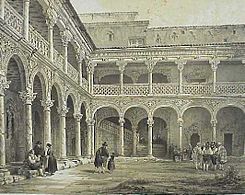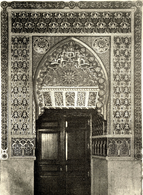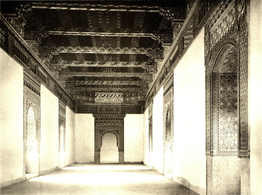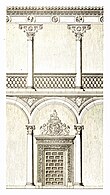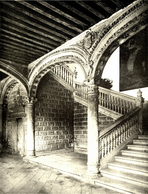Archiepiscopal Palace of Alcalá de Henares: Difference between revisions
No edit summary |
No edit summary |
||
| Line 22: | Line 22: | ||
}} |
}} |
||
| ⚫ | |||
The '''Archbishop's Palace of Alcalá de Henares''' ([[Spanish language|Spanish]]: ''Palacio Arzobispal de Alcalá de Henares'') is a palace located in [[Alcalá de Henares]], [[Spain]]. It is now home to the [[Roman Catholic Diocese of Alcalá de Henares|Diocese of Alcalá de Henares]]. It is located in the Plaza del Palacio and is form part of the monumental set declared [[World Heritage Site]] by [[UNESCO]].<ref name="bic">{{Bien de Interés Cultural}}</ref> |
The '''Archbishop's Palace of Alcalá de Henares''' ([[Spanish language|Spanish]]: ''Palacio Arzobispal de Alcalá de Henares'') is a palace located in [[Alcalá de Henares]], [[Spain]]. It is now home to the [[Roman Catholic Diocese of Alcalá de Henares|Diocese of Alcalá de Henares]]. It is located in the Plaza del Palacio and is form part of the monumental set declared [[World Heritage Site]] by [[UNESCO]].<ref name="bic">{{Bien de Interés Cultural}}</ref> |
||
| ⚫ | |||
The entire set dating from 1209. Two thirds were destroyed as a result of a devastating fire in 1939, during the [[Spanish Civil War]]. What remains is that still after the fire and no restore it the rest.<ref>[http://www.rutasconhistoria.es/loc/palacio-arzobispal-de-alcala-de-henares "Palacio arzobispal de Alcalá de Henares" Rutas con Historia (in Spanish)]</ref> |
The entire set dating from 1209. Two thirds were destroyed as a result of a devastating fire in 1939, during the [[Spanish Civil War]]. What remains is that still after the fire and no restore it the rest.<ref>[http://www.rutasconhistoria.es/loc/palacio-arzobispal-de-alcala-de-henares "Palacio arzobispal de Alcalá de Henares" Rutas con Historia (in Spanish)]</ref> |
||
In this building came to reside different [[List of Castilian monarchs|Castilian monarchs]], were held synods and councils, and in here were born the youngest daughter of the [[Catholic Monarchs]] and future [[List of English monarchs|queen of England]], [[Catherine of Aragon]], and the [[Holy Roman Emperor|German Emperor]] [[Ferdinand I, Holy Roman Emperor|Ferdinand]], son of [[Joanna of Castile|Joanna "the Mad"]] . In addition, it is famous for being the place where was performed the first meeting between the Catholic Monarchs and [[Christopher Columbus]].<ref>[http://www.turismoalcala.es/que-visitar/monumentos/29-palacio-arzobispal-antiquarium-recinto-amurallado.html "Archbishop's Palace. Antiquarium and Walled" turismoalcala.es (in Spanish)]</ref> |
In this building came to reside different [[List of Castilian monarchs|Castilian monarchs]], were held synods and councils, and in here were born the youngest daughter of the [[Catholic Monarchs]] and future [[List of English monarchs|queen of England]], [[Catherine of Aragon]], and the [[Holy Roman Emperor|German Emperor]] [[Ferdinand I, Holy Roman Emperor|Ferdinand]], son of [[Joanna of Castile|Joanna "the Mad"]] . In addition, it is famous for being the place where was performed the first meeting between the Catholic Monarchs and [[Christopher Columbus]].<ref>[http://www.turismoalcala.es/que-visitar/monumentos/29-palacio-arzobispal-antiquarium-recinto-amurallado.html "Archbishop's Palace. Antiquarium and Walled" turismoalcala.es (in Spanish)]</ref> |
||
| ⚫ | The Archbishop's Palace owes its name to that Alcalá for eight hundred years belonged to the jurisdiction of the archbishops of Toledo, who were also the primates -the most preeminents- of all Spain, and that here had their residence. This made that Alcalá de Henares was always at the center of religious power, which for centuries was also synonymous with the political. |
||
== History == |
== History == |
||
[[File:Alcalá de Henares Palacio Arzobispal 6045.JPG|thumb|Tower of [[Pedro Tenorio (archbishop)|Tenorio]].]] |
[[File:Alcalá de Henares Palacio Arzobispal 6045.JPG|thumb|Tower of [[Pedro Tenorio (archbishop)|Tenorio]].]] |
||
First it was a [[Mudéjar]] fortress commissioned in 1209 by Archbishop [[Rodrigo Jiménez de Rada]] (1209-1247), as a temporary residence of the archbishops of Toledo (Alcalá belonged to the archdiocese) and hence its name. It has suffered several fires and destructions, and has been remodeled several times to the present.<ref>[http://cvc.cervantes.es/artes/ciudades_patrimonio/alcala_henares/paseo/palacio_arzobispal.htm Palacio Arzobispal. Centro Virtual Cervantes. Instituto Cervantes; 2012.]</ref> |
First it was a [[Mudéjar]] fortress commissioned in 1209 by Archbishop [[Rodrigo Jiménez de Rada|Rodrigo Ximénez de Rada]] (1209-1247), as a temporary residence of the archbishops of Toledo (Alcalá belonged to the archdiocese) and hence its name. It has suffered several fires and destructions, and has been remodeled several times to the present.<ref>[http://cvc.cervantes.es/artes/ciudades_patrimonio/alcala_henares/paseo/palacio_arzobispal.htm Palacio Arzobispal. Centro Virtual Cervantes. Instituto Cervantes; 2012.]</ref> |
||
In the Archbishop's Palace were held the Courts in 1348 and was enacted the Ordinance of Alcalá, in that was unified the administration of justice to all the lands that formed the [[Crown of Castile]]. |
In the Archbishop's Palace were held the Courts in 1348 and was enacted the Ordinance of Alcalá, in that was unified the administration of justice to all the lands that formed the [[Crown of Castile]]. |
||
| Line 54: | Line 49: | ||
Currently, from 1991, it is the seat of [[Roman Catholic Diocese of Alcalá de Henares|Bishopric of Alcalá de Henares]], and residence of the bishop. |
Currently, from 1991, it is the seat of [[Roman Catholic Diocese of Alcalá de Henares|Bishopric of Alcalá de Henares]], and residence of the bishop. |
||
===Disatrous fire of 1939=== |
|||
[[File:Complete view of Archbishop's Palace of Alcalá before the 1939 fire.jpg|thumb|right|An old photo showing a complete and aereal view of the Archbishop's Palace of Alcalá before the disatrous 1939 fire.]] |
|||
[[File:Recreation of Archbishop's Palace of Alcalá before the 1939 fire.jpg|thumb|right|Recreation of the Archbishop's Palace of Alcalá before the 1939 fire, with description (in Spanish).]] |
|||
The Archbishop's Palace was barracks of tanks and ammunitions, both during and after the [[Spanish Civil War|Civil War]], when, for the failure to prevent flammable materials that were there there was a big fire. It was not the first suffered in its long history, but one of the most voracious, because it destroyed much of the buildings and of the documentation kept there three centuries.<ref>[http://www.dream-alcala.com/palacio-arzobispal/ "Palacio Arzobispal", Dream Alcalá dream-alcala.com]</ref> |
|||
To get an idea of the artistic treasures that were lost in the Archbishop's Palace, here is a short list: the Mudéjar coffered ceiling of the Hall of Councils, the Monumental staircase of Covarrubias, author of the façade-, the Courtyard of Fonseca, the Courtyard of the Hallelujah, the facade of the Courtyard of the Ave Maria, paintings and the first Archaeological Museum of the city. |
|||
==The building== |
|||
| ⚫ | |||
The building has undergone numerous constructions and rehabilitations, being especially devastating the fire of August 11, 1939, which destroyed two thirds of its structure: three courtyards ("the Fonseca or the Covarrubias", the "Hallelujah" and the "of the Fountain or the Small garden"), the "Staircase of honor", the "Facade of the Ave Maria", which was of [[Herrerian]] style and the "Garden of the Vicar". A renovation was completed in 1996 and was necessary.<ref>Sánchez Montes AL. Memory of the Archaeological excavations at the Archbishop's Palace of Alcalá de Henares. Madrid: Directorate General of Historical Heritage. Community of Madrid; 1992.</ref><ref>Sánchez Moltó MV, Arnaiz Gorroño MJ, Pavón Maldonado B. Guidebook of the visitor of the Archbishop's Palace of Alcalá de Henares. Chronicling of its last reconstruction (2 volumes). Alcalá de Henares: Bishopric of Alcala de Henares; 1996. ISBN 84-89285-07-1</ref> |
|||
Entering through the parade courtyard, appears the [[Renaissance]] main facade of the building. It is divided into two bodies, being the low of ashlar, with two floors of [[Plateresque]] windows that joins an upper gallery of gemanates arches. On the central window is a [[Baroque]] coat of terracotta, which replaced the imperial of [[Charles V, Holy Roman Emperor]]. The blazon is of the Cardinal-Infante [[Luis of Spain, Count of Chinchón|Luis Antonio of Bourbon]], son of [[Philip V of Spain|Philip V]], first Bourbon replacing the [[Habsburg Spain|Habsburg]] dynasty. This courtyard is closed at south by a cast iron grille, made in Belgium in the 19th century.<ref>[http://e-spacio.uned.es/fez/eserv.php?pid=bibliuned:ETFSerieVII-2011-24-2190&dsID=Documento.pdf Consuegra Gandullo A. Alcázar-Archbishop's Palace of Alcalá de Henares: past, present and future of a National Monument in a City World Heritage Site. Space, time and form. Serie VII, Historia del arte. 2011; (24):417-44.]</ref> |
|||
In the east wing, where was the "Hall of Councils", was done in the 19th century a major restoration in its exterior and interior by Juan José Urquijo y Manuel Laredo, following the [[Neo-Mudéjar]] style. In 1997 was opened the restored [[Gothic Revival architecture|neo-Gothic]] chapel that replaces the missing Hall of Councils. In the lower floor has made a modern auditorium, replacing the "Hall of the Queen Isabella".<ref>[http://web.archive.org/web/http://www.portal-local.com/tuho_mon_pala_arzo.asp Palacio Arzobispal de Alcalá de Henares. Portal Local. 2012]</ref> |
|||
=== Missing elements === |
|||
<gallery mode=packed heights="130px"> |
|||
File:A courtyard was in Archbishop's Palace of Alcalá before the 1939 fire.jpg|Courtyard. |
|||
File:Constantin Uhde (1888) Puerta de la antesala en el Palacio Arzobispal de Alcalá de Henares.png|Door of the anteroom to the Hall of Councils. |
|||
File:Constantin Uhde (1888) Salón de Concilios en el Palacio Arzobispal de Alcalá de Henares.png|Hall of Councils. |
|||
File:118b Tafel 8 - Alcala de Henares, Hof im erzbischöflichen Palaste 1534.jpg|Courtyard of [[Alonso III Fonseca|Fonseca]]. |
|||
File:Constantin Uhde (1888) Escalera de Covarrubias en el Palacio Arzobispal de Alcalá de Henares.png|Staircase of [[Alonso de Covarrubias|Covarrubias]]. |
|||
File:Alcalá de Henares. Puerta interior del Palacio Arzobispal.jpg|Inner door with the coat of [[Juan Pardo de Tavera|Tavera]]. |
|||
| ⚫ | |||
</gallery> |
|||
==Antiquarium museum== |
|||
In the Archbishop's Palace it were again rebuilt several parties burned, others were restored, and still continue rescuing parts of those gems. Through the Tower XIV it can access the Antiquarium and visit some of those aforementioned remains, which have recreated partially the galleries of the Ave Maria, the large Courtyard of Fonseca and the famous Staircase of Covarrubias. |
|||
For decades held in Alcalá the representation outside of the play "Don Juan Tenorio" by José de Espronceda, in several Alcalá's monuments, and one of it is always the Archbishop's Palace, even some year has staged exclusively there. |
|||
==Toponymy== |
|||
| ⚫ | The Archbishop's Palace owes its name to that [[Alcalá de Henares]] for eight hundred years belonged to the jurisdiction of the [[Roman Catholic Archdiocese of Toledo|archbishops of Toledo]], who were also the primates -the most preeminents- of all Spain, and that here had their residence. This made that Alcalá de Henares was always at the center of religious power, which for centuries was also synonymous with the political. |
||
== References == |
== References == |
||
Revision as of 15:29, 16 April 2016
| Archbishop's Palace of Alcalá de Henares | |
|---|---|
| Native name Spanish: Palacio Arzobispal de Alcalá de Henares | |
 The remnant Archbishop's Palace after the fire. | |
| Location | Alcalá de Henares, Spain |
| Official name | Palacio Arzobispal de Alcalá de Henares |
| Type | Non-movable |
| Criteria | Monument |
| Designated | 1931[1] |
| Reference no. | RI-51-0000727 |
The Archbishop's Palace of Alcalá de Henares (Spanish: Palacio Arzobispal de Alcalá de Henares) is a palace located in Alcalá de Henares, Spain. It is now home to the Diocese of Alcalá de Henares. It is located in the Plaza del Palacio and is form part of the monumental set declared World Heritage Site by UNESCO.[1]
The entire set dating from 1209. Two thirds were destroyed as a result of a devastating fire in 1939, during the Spanish Civil War. What remains is that still after the fire and no restore it the rest.[2]
In this building came to reside different Castilian monarchs, were held synods and councils, and in here were born the youngest daughter of the Catholic Monarchs and future queen of England, Catherine of Aragon, and the German Emperor Ferdinand, son of Joanna "the Mad" . In addition, it is famous for being the place where was performed the first meeting between the Catholic Monarchs and Christopher Columbus.[3]
History

First it was a Mudéjar fortress commissioned in 1209 by Archbishop Rodrigo Ximénez de Rada (1209-1247), as a temporary residence of the archbishops of Toledo (Alcalá belonged to the archdiocese) and hence its name. It has suffered several fires and destructions, and has been remodeled several times to the present.[4]
In the Archbishop's Palace were held the Courts in 1348 and was enacted the Ordinance of Alcalá, in that was unified the administration of justice to all the lands that formed the Crown of Castile.
In 1308 it met the kings Ferdinand IV of Castile and James II of Aragon to agree and sign the Treaty of Alcalá de Henares by which were distributed the territories obtained to al-Andalusian Taifas during the Reconquista.
Also in the 14th century, Archbishop Pedro Tenorio (1377-1399) rebuild the building fortifying it. He built a parade courtyard, rectangular, of more than 2 hectares. Surrounded by a walls with 21 towers; all rectangular less the albarrana of pentagonal, and the attached to it a semicircular plan. Currently are 16 towers, highlighting the "Tower of Tenorio" nominated in memory of the Archbishop.
In the 15th century, Archbishop Juan Martínez Contreras (1423-1434) build the east wing, decorated with large Gothic windows, the Anteroom and Hall of the Councils. The latter two were connected by a large túmido arc (in pointed horseshoe), and covered by a formidable Gothic-Mudéjar coffered ceiling.
On 20 January 1486, here was held the first interview between the queen Isabella I of Castile with Christopher Columbus to finance the trip to the Indies.[5]
In 1524 Archbishop Alonso de Fonseca y Ulloa (1523-1534) commissioned to the architect Alonso de Covarrubias the construction of the west wing, with its courtyards and its magnificent staircase. His successor, Cardinal Juan Pardo de Tavera (1534-1545), finish the work.
Throughout its existence it housed in its inside the archives of the diocese of Toledo. Subsequently its facilities were used for the custody of the Notary Clerks and the Judicial revenue. And from 1858 to 1939 was the Central General Archive of Alcalá de Henares. [6]
Given the saturation of the Archivo de Simancas and its distance to the Court of Madrid, was determined the creation of the Central General Archive in 1858 in the Archbishop's Palace after its assignment to the State for this purpose by Archbishop Cirilo de Alameda y Brea (1857-1872).[7] This Archive received documents from the ministries and agencies suppressed following the reform of 1834. After the regulatory deadlines it forwarded the documents to the National Historical Archive, until that in August 12, 1939 a fire destroyed the Central General Archive. Its successor, from 1969 is General Archive of the Administration (AGA), also in Alcalá de Henares. [8]
Currently, from 1991, it is the seat of Bishopric of Alcalá de Henares, and residence of the bishop.
Disatrous fire of 1939

The Archbishop's Palace was barracks of tanks and ammunitions, both during and after the Civil War, when, for the failure to prevent flammable materials that were there there was a big fire. It was not the first suffered in its long history, but one of the most voracious, because it destroyed much of the buildings and of the documentation kept there three centuries.[9]
To get an idea of the artistic treasures that were lost in the Archbishop's Palace, here is a short list: the Mudéjar coffered ceiling of the Hall of Councils, the Monumental staircase of Covarrubias, author of the façade-, the Courtyard of Fonseca, the Courtyard of the Hallelujah, the facade of the Courtyard of the Ave Maria, paintings and the first Archaeological Museum of the city.
The building

The building has undergone numerous constructions and rehabilitations, being especially devastating the fire of August 11, 1939, which destroyed two thirds of its structure: three courtyards ("the Fonseca or the Covarrubias", the "Hallelujah" and the "of the Fountain or the Small garden"), the "Staircase of honor", the "Facade of the Ave Maria", which was of Herrerian style and the "Garden of the Vicar". A renovation was completed in 1996 and was necessary.[10][11]
Entering through the parade courtyard, appears the Renaissance main facade of the building. It is divided into two bodies, being the low of ashlar, with two floors of Plateresque windows that joins an upper gallery of gemanates arches. On the central window is a Baroque coat of terracotta, which replaced the imperial of Charles V, Holy Roman Emperor. The blazon is of the Cardinal-Infante Luis Antonio of Bourbon, son of Philip V, first Bourbon replacing the Habsburg dynasty. This courtyard is closed at south by a cast iron grille, made in Belgium in the 19th century.[12]
In the east wing, where was the "Hall of Councils", was done in the 19th century a major restoration in its exterior and interior by Juan José Urquijo y Manuel Laredo, following the Neo-Mudéjar style. In 1997 was opened the restored neo-Gothic chapel that replaces the missing Hall of Councils. In the lower floor has made a modern auditorium, replacing the "Hall of the Queen Isabella".[13]
Missing elements
-
Courtyard.
-
Door of the anteroom to the Hall of Councils.
-
Hall of Councils.
-
Courtyard of Fonseca.
-
Staircase of Covarrubias.
-
Inner door with the coat of Tavera.
-
Archbishop's Palace just after the fire.
Antiquarium museum
In the Archbishop's Palace it were again rebuilt several parties burned, others were restored, and still continue rescuing parts of those gems. Through the Tower XIV it can access the Antiquarium and visit some of those aforementioned remains, which have recreated partially the galleries of the Ave Maria, the large Courtyard of Fonseca and the famous Staircase of Covarrubias.
For decades held in Alcalá the representation outside of the play "Don Juan Tenorio" by José de Espronceda, in several Alcalá's monuments, and one of it is always the Archbishop's Palace, even some year has staged exclusively there.
Toponymy
The Archbishop's Palace owes its name to that Alcalá de Henares for eight hundred years belonged to the jurisdiction of the archbishops of Toledo, who were also the primates -the most preeminents- of all Spain, and that here had their residence. This made that Alcalá de Henares was always at the center of religious power, which for centuries was also synonymous with the political.
References
- ^ a b Template:Bien de Interés Cultural
- ^ "Palacio arzobispal de Alcalá de Henares" Rutas con Historia (in Spanish)
- ^ "Archbishop's Palace. Antiquarium and Walled" turismoalcala.es (in Spanish)
- ^ Palacio Arzobispal. Centro Virtual Cervantes. Instituto Cervantes; 2012.
- ^ Palacio Arzobispal. Alcalá de Henares, photo to photo. 27/07/2008.
- ^ Ruinas del Palacio Arzobispal. Alcalá de Henares, photo to photo. 17/01/2010.
- ^ Royal Decree of July 17, 1858
- ^ History of the General Archive of the Administration. Ministry of Culture of Spain. 05/12/2011.
- ^ "Palacio Arzobispal", Dream Alcalá dream-alcala.com
- ^ Sánchez Montes AL. Memory of the Archaeological excavations at the Archbishop's Palace of Alcalá de Henares. Madrid: Directorate General of Historical Heritage. Community of Madrid; 1992.
- ^ Sánchez Moltó MV, Arnaiz Gorroño MJ, Pavón Maldonado B. Guidebook of the visitor of the Archbishop's Palace of Alcalá de Henares. Chronicling of its last reconstruction (2 volumes). Alcalá de Henares: Bishopric of Alcala de Henares; 1996. ISBN 84-89285-07-1
- ^ Consuegra Gandullo A. Alcázar-Archbishop's Palace of Alcalá de Henares: past, present and future of a National Monument in a City World Heritage Site. Space, time and form. Serie VII, Historia del arte. 2011; (24):417-44.
- ^ Palacio Arzobispal de Alcalá de Henares. Portal Local. 2012

